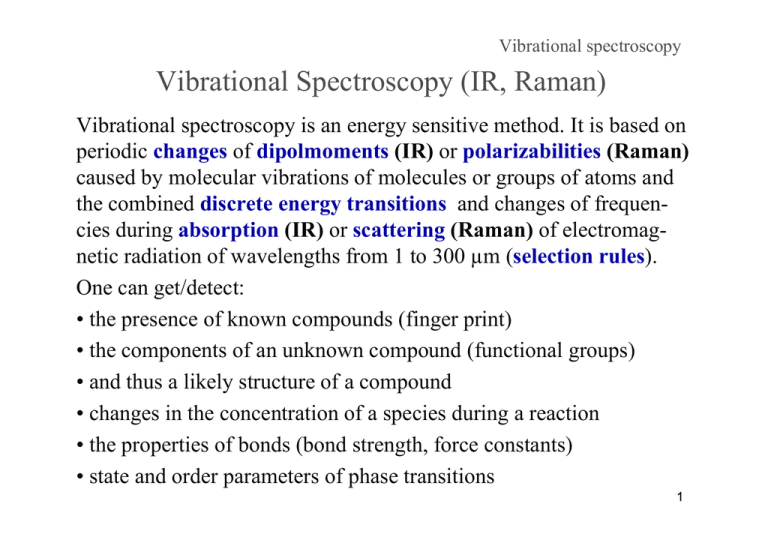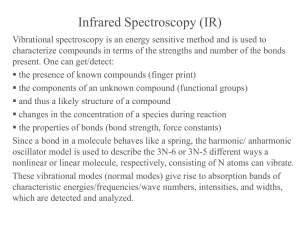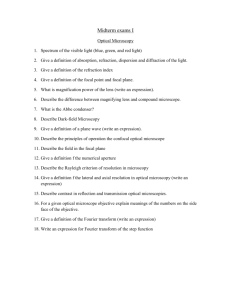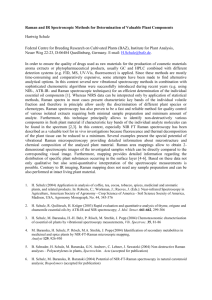Vibrational Spectroscopy (IR, Raman)
advertisement

Vibrational spectroscopy Vibrational Spectroscopy (IR, Raman) Vibrational spectroscopy is an energy sensitive method. It is based on periodic changes of dipolmoments (IR) or polarizabilities (Raman) caused by molecular vibrations of molecules or groups of atoms and the combined discrete energy transitions and changes of frequencies during absorption (IR) or scattering (Raman) of electromagnetic radiation of wavelengths from 1 to 300 µm (selection rules). One can get/detect: • the presence of known compounds (finger print) • the components of an unknown compound (functional groups) • and thus a likely structure of a compound • changes in the concentration of a species during a reaction • the properties of bonds (bond strength, force constants) • state and order parameters of phase transitions 1 Vibrational spectroscopy Vibrational Spectroscopy (IR, Raman) In order to describe the 3N-6 or 3N-5 different possibilities how non-linear and linear molecules containing N atoms can vibrate, the models of the harmonic and anharmonic oscillators are used. These modes of vibration (normal modes) give rise to • absorption bands (IR) if the sample is irradiated with polychromatic light of suitable wavelengths upon changes of the dipole moment μ = α ·E + β ·E2 + … • scattered light (Raman) if the sample is irradiated with monochromatic light of a suitable wavelength upon changes of the polarizabilities α with characteristic energies/frequencies/wavenumbers, intensities and Fwhm’s to be determined and analyzed. The frequencies are in the range of 1012 to 3·1014 Hz with vibrational energies from 0.4 to 120 kJ/mole (4·10-3 - 1.24 eV), wavenumbers from 33 to 104 cm-1, and wavelenghts from 300 to 1 μm. The intensities are proportional to the square of the changes of the dipole moments and polarizabilities. 2 Vibrational Spectroscopy Wavelengths and energies in vibrational spectroscopy Vis, IR, and Raman areas drawn in a scale of linear wavenumbers and some lasers sources Wavenumber reciprocal of λ: 1/λ (cm-1) Wavelength in nm 3 Vibrational Spectroscopy Vibrational Spectroscopy - the main principle H r0 Hooke´s law Cl Spring with rate/spring constant k Extension from r0 (equilibrium distance) Absorption of energy E k Relaxation to r0 Vibration Center of mass is not allowed oo shift during the vibration F=-kx V = ∫-F dx = ∫k x dx V = ½ k x2 Together with molecular vibrations also molecular rotations are excited as well since rotational energies are much smaller (~ 0.01·Evib.)! 4 Vibrational Spectroscopy Harmonic vibrational levels Potential curve V= F=-kx V = ∫-F dx = ∫k x dx V = ½ k x2 ν~ ~ k/μ ν~= Wavenumber k = rate/force constant μ = reduced mass μ= m1m2 m1 + m2 Zero-point vibration Zero-opint energy E0 Harmonic Oszillator F = -kx = m·b = m·d2x/dt2 → ν0 = (1/2π)·(k/m)1/2 Warning: Molecular vibrations are essentially anharmonic! 5 Vibrational Spectroscopy Vibrational energy levels in harmonic/anharmonic approximation condition for IR dμ ≠ 0, condition for Raman: dα ≠ 0 Selection rules! Δn = ±1 Potential curve of the harmonic oscillator (En: Vibrational levels, E0: Zero-point energy) EVIB = hνosc(n + ½) - h2ν2/(4ED)· (n + ½)2 (Δn = ±1, ±2, ...) For anharmonic vibrations the distances of neighboring vibrational levels decrease with increasing n (the thickness of the arrows stand for the transition probabilities and intensities respectively). Potential curve of the anharmonic oscillator (E0: Zero-point energy, ED: Dissociation energy) 6 Vibrational Spectroscopy Vibrational states and frequencies Excitation of a vibrational state in the electronic ground state S0 by a: infrared absorption, b: Raman scattering, c: inelastic neutron scattering, d: fluorescence. Vibrational coupling in zig-zag chains Variation of frequencies in case of a free molecule (a), of different lengths static (b) and dynamical (c) coupling in a crystal lattice, and dependence on the wave vector k for all unit cells 7 Normal modes Vibrational Spectroscopy Each atom of a molecule (structure) has three degrees of freedom (dof) with respect to displacements, resulting in 3N dof for N atoms. Substracting the dof for translations (3) and rotations (3 or 2), 3N-6 and 3N-5 degrees of freedom are expected for non-linear and linear N-atomic molecules, respectively. The corresponding vibrations are called normal modes. It is valid that: 1. All atoms of a molecule move with the same frequency and in phase, and they move simultaneously through the points of maximum elongation and equilibrium displacement r0 while the mass center remains unchanged. 2. The amplitudes of the different particles can be different. 3. The normal vibrations (typically) do not interfere with each other (orthogonality principle). 4. The number of normal vibrations (vibrational degree of freedom) is 3N-6 for non-linear molecules 3N-5 for linear molecules 8 Normal modes Vibrational Spectroscopy Every vibrational mode exhibits its own “pattern (vector, matrix)” for the atomic displacements (±Δx, ±Δy, ±Δy), leading to normal coordinates, but the vibrational modes are usually not known: Assignment of the vibrational modes via symmetry properties of the molecules (point group, irreducible representation, character, character tables). Symmetry of vibrations (symmetry species = Rassen, types of vibration) Symmetry species (Rassen) of the modes are denoted after Mulliken: A = symmetric, B = antisymmetric with respect to Cn; E, F, G, H = 2-, 3-, 4-, 5-fold degenerate with respect to Cn; g = symmetric with respect to i (from German gerade); u = antisymmetric with respect to i (from German ungerade); Index subscripts of A or B: 1 = symmetric, 2 = antisymmetric with respect to Cn or Sn (a mirror plane); Example: A2g is a vibration that is symmetric with respect to Cn and i (character = 1) and antisymmetric with respect to Sn or σ (character = -1). 9 Normal modes Point group Symmetry operations Symbol Active vibrations in C3v E 2C3 3σv A1 1 1 1 z A2 1 1 -1 Rz E 2 -1 0 (x,y) (Rx,Ry) Symmetry species (Rassen) Group characters IR Raman x2+y2, z2 (x2-y2, xy) (xz, yz) Combinations of the symbols x, y, z, Rx, Ry and Rz, the first three of which represent the coordinates x, y and z, and the last three of which stand for rotations about these axes. These are related to transformation properties and basis representations of the group. Character table for space group C3v 10 Vibrational Spectroscopy Normal modes (Examples) 3N – 6 Modes (3N – 5, if linear) ν1 ν~ ~ k / μ ν = Wavenumber k = Force constant μ = Reduced mass ν2 ν3 = ν4 ν4 = ν3 Three normal vibrations of H2O and their wavenumbers Four normal vibrations of CO2 (linear) 11 Auswahlregeln Vibrational Spectroscopy Normal modes of vibration (IR-) activity Dipole moment changes during the vibration! Stretching vibration Changes of bond lengths IR-aktiv O O H H C O IR-aktiv νasym: 2350 cm-1 νsym: 3652 cm-1 O O IR-aktiv O νasym: 1340 cm-1 H H C IR-inaktiv (Raman-aktiv) νasym: 3756 cm-1 Bending vibration Changes of bond angles IR-aktiv H O O H -1 νsym: 1596 cm C O 666 cm-1 entartet O + C - -1 IR-aktiv O + 666 cm entartet 12 Normal modes (Examples) S14 13 Normal modes (Examples) 14 Normal modes (Examples) 15 Schwingungsspektroskopie Typical values for stretching and bending vibrations “Molecule“ stretching C-H 2800 - 3000 N-N 3300 - 3500 H2O 3600 - 3000 C=O 1700 C=C 1600 SO32- 970 (νs) 930 (νas) bending 1600 620 (γ) 470 (δ) 16 IR-Spectroscopy Sources for IR- (and Raman-) radiation Conventional lamps are not adequate, because near IR: ~ 700 to 1400 nm; mid-wavelength/far IR: > 1400 nm 17 IR-Spektroskopie IR-Source (Globar, Nernst-Lamp) new schematic used Globar (SiC, ~1.500 K) Nernst lamp with Nernst rod ZrO2/Y2O3 ionic conductor, 1.900 K All heated materials emit infrared radiation http://www.techniklexikon.net/d/nernst-brenner/nernst-brenner.htm 18 IR-Spektroskopie IR-sources, monochromators and detectors Range Source Monochromator Detector Far IR Nernst rod (ceramic rod CsI-prism; grating Bolometer Mid IR with heating coil) LiF-prism; grating Bolometer Near IR Light-bulb PbS-Cell; Se-Cell quartz-prism Nernst rod: cub. ZrO2 stabilized by rare earth elements (e.g.. Y3+) Near IR: ~ 700 bis 1400 nm; Mid-wavelenght/Far IR: > 1400 nm 19 IR-Spectroscopy IR-Detectors Main principle and a picture of a bolometer: A cooled metal foil (Pt, Au) absorbs IR radiation. The resulting rise of the temperature is detected by a resistor-type thermometer. 20 IR-Spectroscopy IR - Spectrometer Double beam, optical grating Fourier-Transform (FT) 21 IR-Spectroscopy Fourier-transform spectroscopy “Classical” (grating, prism) IR spectroscopy has been replaced by the much faster FTIR spectroscopy. In the case of the “classical” (i.e. non FT) infrared spectroscopy the different wavelengths had to be measured successively. In the case of the FTIR technique the complete range of interest is measured at once. The fundamental instrument for FTIR is the Michelson interferometer that replaces the monochromator. The sample is irradiated by polychromatic light and a movable mirror produces a time dependent signal that is transformed by Fourier transformation into a frequency spectrum. 22 IR-Spectroscopy Fouriertransform (FT) spectrometry a) Michelson Interferometer S radiation source, Sa sample chamber, D detector, A amplifier, M1 fixed, M2 movable mirror, BS beam splitter, x mirror deflection, L distance b) Interferogram Signal recorded by the detector c) Spectrum Obtained by Fourier transform (FT) From the interferogram Schematic representation of a Michelson interferometer (a) with interferogram (b) and spectrum (c) obtained by Fourier transform. 23 IR-Spectroscopy Examples from current research activities BaSO3 Cs2CrCl5·4H2O ν(PH) 758 Sr(HPO2OH)2 RT KMn(SeO2OH)3 3214 3080 2881 686 1226 2439 2433 1168 779 Transm ission 694 γ(OH) 1235 TT 3191 3032 2899 Sr(SeO2OH)2 RT 2440 2434 1170 δ(OH) 2300 2400 1225 1155 3176 3019 2303 2432 TT 3500 3175 2963 3000 2783 1241 685 1164 νB(OH) 2500 1300 1150 1000 850 700 ν/cm-1 400 24 Raman spectroscopy Raman spectroscopy Irradiation of a sample with monochromatic light of a suitable wave length may force oscillations of the electrons. A small portion (IRayleigh/I0 ~ 10-5) of the absorbed radiation energy is scattered with the same frequency as the incident light into all directions of space (elastic, Rayleigh scattering). An even smaller portion (IRaman(Stokes)/I0 ~ 10-8) of the irradiated energy will be transformed into molecular vibrations (with a corresponding change of the polarizability tensor α) and thus leads to an absorption of vibrational energy from the scattered light. The scattered light therefore has a lower frequency than the irradiated light (inelastic, Raman scattering, Stokes). If the radiation interacts with a vibrational excited molecule then the scattering process may result in an emission of energy to the scattered light. Thus the scattered light has a larger frequency compared to the irradiated light (inelastic, Raman scattering, anti-Stokes, IRaman(anti-Stokes)/I0 ~ 10-11). Raman scattering requires a change of the polarizability α. The intensity of the scattered light is proporional to the square of the change of the polarizability. 25 Raman spectroscopy Selection rules Condition: dα ≠ 0 Δn = ±1 (harmonic) Δn = ±1, ±2, ±3 … (anharmonic) (IRayleigh ~ 10-5·I0) (IRa(anti-St) ~ 10-11·I0) (IRaman(St) ~ 10-8·I0) Schematic representation of the energy levels Raman scattering, anti-Stokes; Rayleigh scattering; Raman scattering, Stokes (ν0 = Frequency of the irradiated light, νM = vibrational frequency of the molecule) Resonance Raman bands with high intensity occur if instead of a forced oscillation an electronically excited state is generated (absorption). 26 Vibrational spectroscopy Molecular vibrations of PCl3 and comparable molecules νs δs δas νas PCl3 is a tetra-atomic molecule with C3v symmetry 27 Raman spectroscopy δs νs, as δas δas δs νs, as Raman spectrum of PCl3 (liquid) in the Stokes- and anti-Stokes range exciting line 514,5 nm ≡ 19436 cm-1 (Ar Laser) 28 Raman spectroscopy Schematic representation for the observation of the Raman effect in 90o arrangement (IRay ~ 10-5·I0) (IRa(St) ~ 10-3·IRay , IRa(anti-St) ~ 10-3·IRa(St)) (z.B. Ar-Laser) The low intensities of the scattered radiation (IRa(St) ~ 10-8·I0, IRa(anti-St) ~ 10-11·I0) requires the use of lasers. 29 Raman spectroscopy Different types of lasers for the use in Raman spectroscopy (and UV-Vis) The use of lasers is necessary because of the low intensity of the scattered light. 30 IR-/Raman spectroscopy Raman and IR active vibrational modes of CO2 Raman active are those vibrations, at which the polarizability α changes Raman condition: dα ≠ 0 (different in the inversion points). IR active are those vibrations, at which the dipole moment μ changes (different IR condition: dμ ≠ 0 in the inversion point). 31 IR-/Raman spectroscopy Exclusion rule in IR and Raman spectra Polarizability changes (δα/δq) of the fundamental modes (νas, νs, δ) and IR and Raman spectra of the CS2 molecule 32 IR-/Raman spectroscopy Exclusion rule in IR and Raman spectra Vibrations symmetrical with respect to i (g) are IR inactive but Raman-ctive Vibrations non-symmetrical with respect to i (u) are IR active but Raman inactive → Exclusion rule Hg2I2 (I4/mmm) I Hg Hg D∞h => 3N-5=7 I νs(HgI) νas(HgI) ν(HgHg) δs(HgHgI) δas(HgHgI) νT. A1g A2u A1g 2Eg 2Eu Eg Ra. IR Ra. Ra IR Ra IR/Raman spectra and vibrational modes of Hg2I2 33 IR-/Raman spectroscopy Temperature effects and exclusion rule νas(HgI) δ(HgHgBr) ν(HgHg) Lattice vibration FIR and Raman spectra of Hg2Br2 34 Raman spectroscopy On-line Raman spectra of the exhaust fumes of a 2 cycle engine 35 IR-/Raman spectroscopy Schematic representation of the energy-levels and spectra of different spectroscopic transitions. The anharmonicity of a vibration is exaggerated and the distance S1-S0 is strongly compressed. A = Absorption, I = Intensity 36 IR-/Ramanspektroskopie Literatur Untersuchungsmethoden in der Chemie – Einführung in die moderne Analytik von H. Naumer und W. Heller, Wiley-VCH Optische Spektroskopie von W. Schmidt, Wiley-VCH Schwingungsspektroskopie von J. Weidlein, U. Müller, K. Dehnike, Georg Thieme Verlag Anwendungen der Schwingungsspektroskopie in der Anorganischen Chemie von H. Siebert, Springer Verlag Infrared and Raman Spectroscopy, Methods and Applications by B. Schrader, Wiley-VCH Molecular Vibrations by E. Bright Wilson Jr., J.C. Decius, P.C. Cross, McGraw-Hill 37






